

Bienvenido/a a este post. Si aún no eres parte de esta Cripto Red Social, te invito a unirte, para que comiences a recibir recompensas por tu actividad online.

Welcome to this post. If you are not yet part of this Crypto Social Network, I invite you to join, so that you can start receiving rewards for your online activity.

Días atrás publiqué una reseña sin spoilers de la serie Moon Knight, en la que me limité a exponer mi apreciación sobre los aspectos generales que creo más importantes para que cualquiera que no la haya visto y lea mi post, pueda hacerse una idea sobre el tipo y calidad de tal producción audiovisual. En cambio, ahora comentaré con mayor libertad, diferentes puntos de la trama que me parecen destacables o dignos de comentar, entre otras cosas estaré haciendo mención de las diferencias que esta adaptación presenta con relación al material original, pues me parece que la forma en que fueron reimaginados algunos elementos de la historia y la forma en que se revelaron otros, que si son muy similares a lo narrado en las viñetas, hacen que la serie posea un fuerte grado de originalidad a la vez que mantiene correctamente la esencia del personaje en los comics.
Antes de comenzar, debo aclarar también que esto no será para nada un resumen en el que simplemente relato toda la serie de forma breve, siguiendo el mismo orden en que ocurrieron los hechos vistos en pantalla, se trata más bien de compartir mi opinión sobre diferentes secuencias que componen la trama, realizando evaluaciones e hipótesis respecto de cada tema, de modo que muy posiblemente este texto no siga una secuencia apegada al orden narrativo de la serie, sino una un tanto caótica y anárquica.
A few days ago I published a spoiler-free review of the Moon Knight series, in which I limited myself to expressing my appreciation of the general aspects that I think are most important so that anyone who has not seen it and reads my post can get an idea about the type and quality of such audiovisual production. On the other hand, now I will comment with greater freedom, different points of the plot that seem remarkable or worthy of comment, among other things I will be mentioning the differences that this adaptation presents in relation to the original material, because it seems to me that the way in which some elements of the story were reimagined and the way in which others were revealed, which if they are very similar to what is narrated in the vignettes, make the series possess a strong degree of originality while correctly maintaining the essence of the character in the comics.
Before starting, I must also clarify that this will not be at all a summary in which I simply tell the whole series briefly, following the same order in which the events seen on the screen occurred, it is rather about sharing my opinion on different sequences that make up the plot, making evaluations and hypotheses regarding each theme, so that very possibly this text does not follow a sequence attached to the narrative order of the series, but rather a somewhat chaotic and anarchic one.

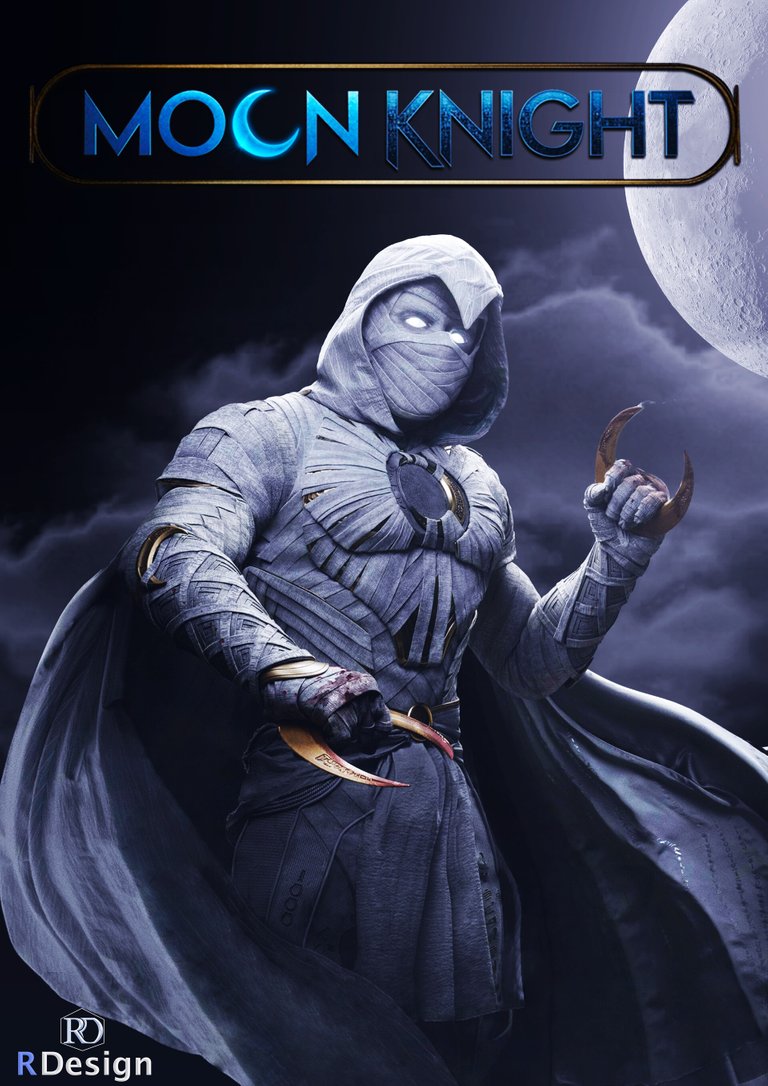

Ya entrando en materia, a diferencia de lo que se esperaría si se conoce la historia del personaje en los comics, la que inicia siendo la identidad “principal” en la serie, al menos en el aspecto narrativo, es la de Steven Grant y no la de Marc Spector, aunque conforme va avanzando la trama comprendemos que realmente la personalidad “original” es la de Marc. Como es costumbre en Marvel Studios, lo que se nos cuenta en la serie no es un calco exacto de lo escrito en las historietas, en este caso Steven es muy diferente al de los comics, pues en lugar de tratarse de un millonario comparable con el alter ego de Batman, en este caso se trata de un hombre tímido y sencillo, que trabaja en un museo y sufre acoso laboral por parte de su jefa.
Por su parte, Marc Spector sí que es un mercenario (tal como en los comics) que estando al borde de la muerte hace un pacto con el dios egipcio Khonsu, para que este le salve la vida, a cambio de convertirse en su avatar en la tierra e impartir justicia por su propia mano en nombre de esa deidad. Para ello, es capaz de invocar un traje místico proporcionado por el dios de la luna, el cual le da super fuerza, resistencia sobre humana e invulnerabilidad, convirtiéndolo en Moon Knight, lo que significa una importante diferencia con respecto al original, ya que su traje no era de carácter sobrenatural como ocurre acá en la serie, sino una vestimenta común y corriente que este hombre se colocaba para ejercer como vigilante enmascarado.
Going into the matter, unlike what would be expected if the history of the character in the comics is known, the one that begins as the "main" identity in the series, at least in the narrative aspect, is that of Steven Grant and not that of Marc Spector, although as the plot progresses we understand that the "original" personality is really Marc's. As is customary in Marvel Studios, what we are told in the series is not an exact copy of what is written in the comics , in this case Steven is very different from the one in the comics, because instead of being a millionaire comparable to Batman's alter ego, in this case he is a shy and simple man, who works in a museum and suffers workplace harassment by his boss.
For his part, Marc Spector is indeed a mercenary (just like in the comics) who, being on the verge of death, makes a pact with the Egyptian god Khonsu, so that he saves his life, in exchange for becoming his avatar in the earth and deliver justice by his own hand in the name of that deity. To do this, he is able to summon a mystical suit provided by the moon god, which gives him super strength, resistance above human and invulnerability, turning him into Moon Knight, which means an important difference from the original, since his The suit was not of a supernatural nature as it happens here in the series, but a common and ordinary outfit that this man put on to act as a masked vigilante.

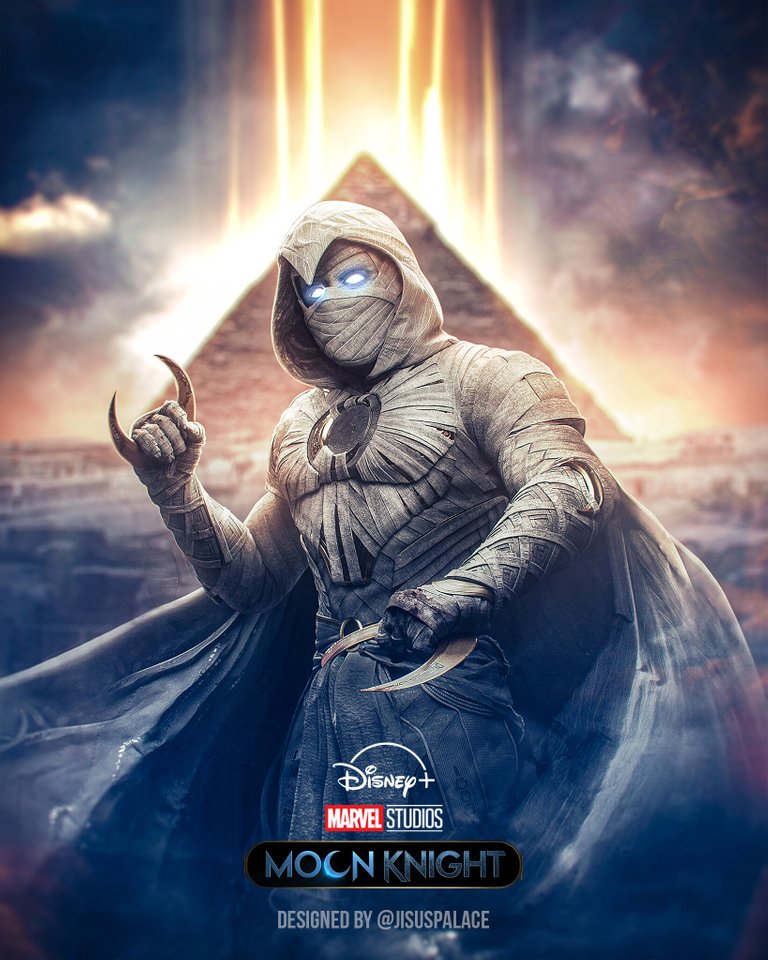

También ocurre igual con el traje de Mr. Knight, que en la adaptación televisiva corresponde a la versión super poderosa de Steven Grant al momento de adquirir las capacidades que le suministra Khonsu, pero que en las historietas es también un traje físico utilizado para personificar a un segundo alter ego superheroico, incluso este rol puede ser considerado (dependiendo de que comic se trate) como otra personalidad independiente de las demás, la cual asume el carácter de detective y es menos violenta que Moon Knight. En mi opinión, estos cambios relativos a la procedencia de los trajes y su correspondencia con las identidades de Marc y Steven, ha sido un enorme acierto de la serie, pues le concede mayor consistencia a la parte mitológica de la historia y le da mucha originalidad al personaje, distanciándolo drásticamente de Batman, ya que no necesita una identidad secreta que costeé la creación de sus armas y artilugios, puesto que todo ello forma parte de su indumentaria generada de manera sobrenatural.
La forma como los trajes son invocados místicamente, me parece excelente, pues de ese modo el personaje está siempre listo para entrar en acción sin necesidad de cambiarse de ropa de la forma tradicional, además, esto permite que pueda pasar muy rápido de un traje a otro, por lo que en una misma batalla pueden participar Marc y Steven de una manera muy dinámica. Por cierto, en el segundo episodio cuando vi por primera vez a Mr. Knight, me pareció que se estaba parodiando a esa identidad y no me gustó que se le representara como un tonto, de hecho, pensé que podía incluso quedarse simplemente en una referencia y no volver a aparecer en la serie; por suerte me equivoqué, luego volvió a aparecer y creo que se le dio una justificación a su existencia, pues se trata de la personalidad de Steven y por tanto los poderes que le otorga el dios egipcio, no se reflejan visualmente de la misma forma que lo hacen con la personalidad de Marc.
The same thing happens with Mr. Knight's suit, which in the television adaptation corresponds to the super powerful version of Steven Grant at the time of acquiring the abilities that Khonsu supplies him, but in the comics it is also a physical suit used to personify Grant. a second superheroic alter ego, even this role can be considered (depending on the comic) as another personality independent of the others, which assumes the character of a detective and is less violent than Moon Knight. In my opinion, these changes related to the origin of the suits and their correspondence with the identities of Marc and Steven, have been a great success of the series, since it gives greater consistency to the mythological part of the story and gives it a lot of originality. to the character, drastically distancing him from Batman, since he does not need a secret identity that pays for the creation of his weapons and gadgets, since all this is part of his supernaturally generated clothing.
The way in which the suits are mystically invoked seems excellent to me, because in this way the character is always ready to go into action without having to change clothes in the traditional way, in addition, this allows him to go very quickly from one suit to another. another, so Marc and Steven can participate in the same battle in a very dynamic way. By the way, in the second episode when I saw Mr. Knight for the first time, it seemed to me that he was parodying that identity and I did not like that he was represented as a fool, in fact, I thought that it could even remain simply a reference and not appear again in the series; luckily I was wrong, then it reappeared and I think its existence was justified, since it is Steven's personality and therefore the powers granted by the Egyptian god, are not visually reflected in the same way as they do it with Marc's personality.

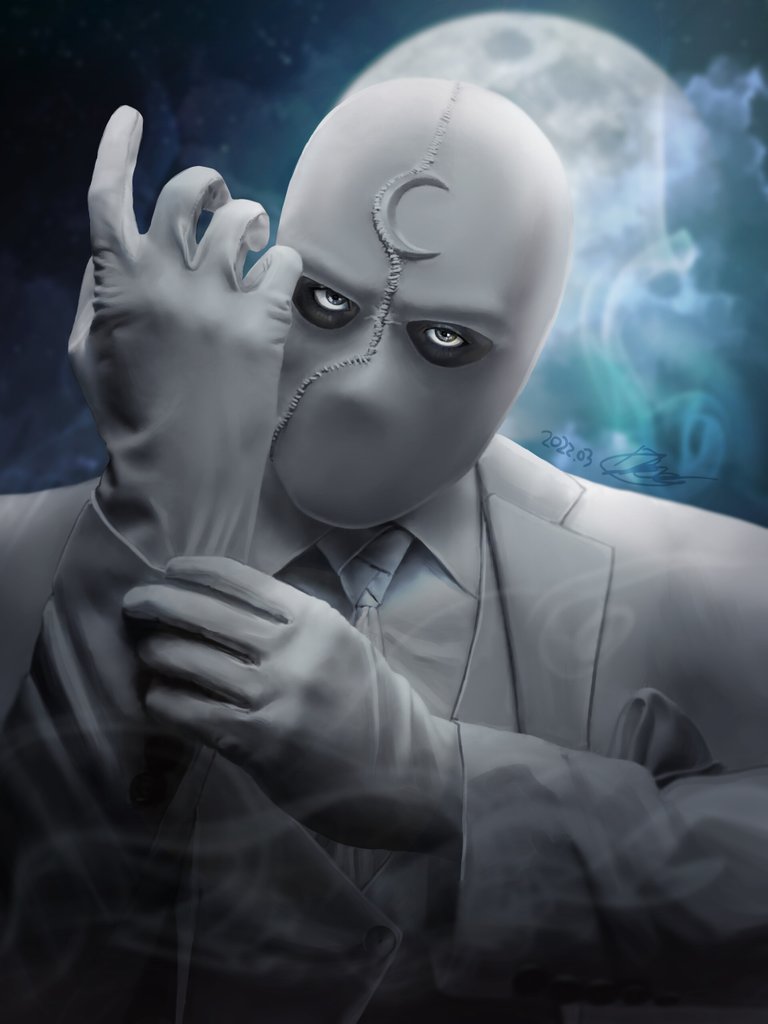

Con respecto a la forma en que luego de haber tenido que cederle el control a Marc debido a no saber combatir, Mr. Knight / Steven Grant se vuelve completamente capaz de pelear como si hubiese recibido entrenamiento para ello, me parece una conveniencia de guion bastante notoria, pero prefiero que sea así y no que él continue siendo incapaz de luchar correctamente. Se que esto se puede justificar, tomando como argumento que ahora Steven es consciente de que en realidad él es una invención de Marc y que ambos son la misma persona, entonces, si uno de ellos es capaz de pelear muy bien, el otro también puede hacerlo. Sin embargo, esa argumentación me parece un poco floja, ya que al mantener las dos personalidades diferenciadas y no haberlas convertido en una misma que mesclé rasgos de ambas, creo que debería permanecer por un tiempo siendo un mal peleador.
Hablemos ahora de la tercera personalidad. Siempre estuve esperando que en algún momento se revelara la identidad de Jake Lockley, de hecho, cuando Marc y Steven se encontraron frente a frente en la Duat (el inframundo de la mitología egipcia), con la diosa hipopótamo, Tueris, realizándoles el juicio de Osiris, aunque Steven descubrió gracias a diferentes regresiones al pasado, a las que accedió por medio de diferentes puertas ubicadas en el sanatorio “imaginario” que su mente creó para representar esa especie de limbo que se ubica entre el más allá y el mundo de los vivos, pero pese a que el secreto de Marc se reveló, de igual forma la balanza no llegó a alinearse para ellos, entendí eso como que no se emparejaba debido a que aún faltaba descubrir los secretos detrás del origen de la identidad faltante.
Creo que se manejó de forma magistral la existencia de esta personalidad, ya que se nos dio pistas de su presencia, pero a la vez se le ocultó para que mantuviéramos la sospecha e incertidumbre. De haberse revelado antes que era esta identidad la que se hacía cargo en última instancia de resolver los enfrentamientos más peligrosos en los que se involucraban las otras identidades, la emoción y sorpresa se habría diluido bastante, pero de este modo todo terminó encajando de manera impecable.
Regarding the way in which after having to give control to Marc due to not knowing how to fight, Mr. Knight / Steven Grant becomes fully capable of fighting as if he had received training for it, it seems to me quite a script convenience notorious, but I prefer it that way and not that he continues to be unable to fight properly. I know that this can be justified, taking as an argument that now Steven is aware that he is actually Marc's invention and that they are both the same person, so if one of them is capable of fighting very well, the other can also do it. However, that argument seems a bit weak to me, since by keeping the two personalities different and not having turned them into the same one that mixed traits of both, I think he should remain a bad fighter for a while.
Let us now speak of the third personality. I was always hoping that at some point the identity of Jake Lockley would be revealed, in fact, when Marc and Steven found themselves face to face in the Duat (the underworld of Egyptian mythology), with the hippopotamus goddess, Tueris, carrying out the judgment of Osiris, although Steven discovered thanks to different regressions to the past, which he accessed through different doors located in the "imaginary" sanatorium that his mind created to represent that kind of limbo that is located between the afterlife and the world of the alive, but despite the fact that Marc's secret was revealed, in the same way the scales did not align for them, I understood that as not matching due to the fact that the secrets behind the origin of the missing identity had yet to be discovered.
I believe that the existence of this personality was masterfully handled, since we were given clues to his presence, but at the same time it was hidden so that we would maintain suspicion and uncertainty. Had it been revealed earlier that it was this identity that was ultimately in charge of solving the most dangerous confrontations in which the other identities were involved, the emotion and surprise would have been diluted quite a bit, but in this way everything ended up fitting together impeccably.



Me parece, que la escena poscréditos en la que se nos muestra a Jake Lockley siendo utilizado por Khonsu como su avatar y acecinando a Arthur Harrow, es la mejor narrativamente hablando, de todas las que nos ha presentado el UCM, ya que, de no haber sido por esta escena, todo lo acontecido en la serie podría haberse entendido como una complicada alucinación en la mente de Marc, pero debido a ella la trama se abre nuevamente y deja el camino libre para que la historia continue en una segunda temporada o en su defecto, en una película bien sea en solitario o en combinación con otros personajes protagónicos.
Es importante recalcar lo que comenté en el post anterior sobre las actuaciones, pues el trabajo de Oscar Isaac es excelente (creo que merece un galardón), la interpretación de las múltiples personalidades es genial y muy diferenciada una de otra, teniendo entre otros detalles distintivos, un dialecto diferente para cada una de ellas. El actor se inmiscuyó mucho en la creación del personaje y aprovechóo su ascendencia latina, para imprimirle un particular estilo a Jake Lockley, que en la serie parece ser latinoamericano (lo cual no es así en los comics), mientras que Steven Grant es un hombre británico y Marc Spector es estadounidense. En este sentido, tampoco puedo dejar de mencionar la labor de Ethan Hawke, quien da vida a Arthur Harrow y lo hace maravillosamente.
En las historietas (donde solo apareció una única vez) Harrow es un inescrupuloso doctor, nominado al Premio Nobel de medicina, que realizaba experimentos en seres humanos relacionados con la teoría del dolor, por lo que a Moon Knight se le asigna la misión de capturarlo en Yucatán (México) donde se encontraba llevando a cabo sus pruebas para ese momento. Por el contrario, en esta producción televisiva, es el líder extremista de un grupo adorador de la diosa egipcia Ammit. La construcción del personaje es bastante sólida y coherente, este antagonista quizá no posea poderes muy espectaculares o una trascendencia que se prolongue más allá de estos seis episodios, pero la interpretación y los rasgos que le imprime el actor, quien se dice que aceptó la invitación hecha por su amigo Oscar Isaac para participar en el proyecto, aun antes de haber leído el guion y pronto se preparó para el papel investigando sobre líderes de sectas religiosas del pasado. Me habría gustado mucho que se nos mostrara más del origen de este villano, en especial su época como avatar de Khonsu.
It seems to me that the post-credits scene in which Jake Lockley is shown being used by Khonsu as his avatar and assassinating Arthur Harrow is the best narratively speaking, of all the ones that the UCM has presented to us, since, if not Had it been for this scene, everything that happened in the series could have been understood as a complicated hallucination in Marc's mind, but because of it the plot opens again and leaves the way clear for the story to continue in a second season or in failing that, in a film either alone or in combination with other leading characters.
It is important to emphasize what I commented in the previous post about the performances, because the work of Oscar Isaac is excellent (I think it deserves an award), the interpretation of the multiple personalities is great and very different from each other, having among other distinctive details , a different dialect for each of them. The actor interfered a lot in the creation of the character and took advantage of his Latin ancestry to imprint a particular style on Jake Lockley, who in the series seems to be Latin American (which is not the case in the comics), while Steven Grant is a man. British and Marc Spector is American. In this sense, I cannot fail to mention the work of Ethan Hawke, who brings Arthur Harrow to life and does it wonderfully.
In the comics (where he only appeared once) Harrow is an unscrupulous doctor, nominated for the Nobel Prize in medicine, who carried out experiments on human beings related to the theory of pain, so Moon Knight is assigned the mission of capturing him. in Yucatan (Mexico) where he was carrying out his tests at that time. On the contrary, in this television production, he is the extremist leader of a group that worships the Egyptian goddess Ammit. The construction of the character is quite solid and coherent, this antagonist may not have very spectacular powers or a transcendence that lasts beyond these six episodes, but the interpretation and the traits that the actor gives him, who is said to have accepted the invitation made by his friend Oscar Isaac to participate in the project, even before he had read the script and he soon prepared himself for the role by researching leaders of religious sects of the past. I would have very much liked to be shown more of the origin of this villain, especially his time as an avatar of Khonsu.

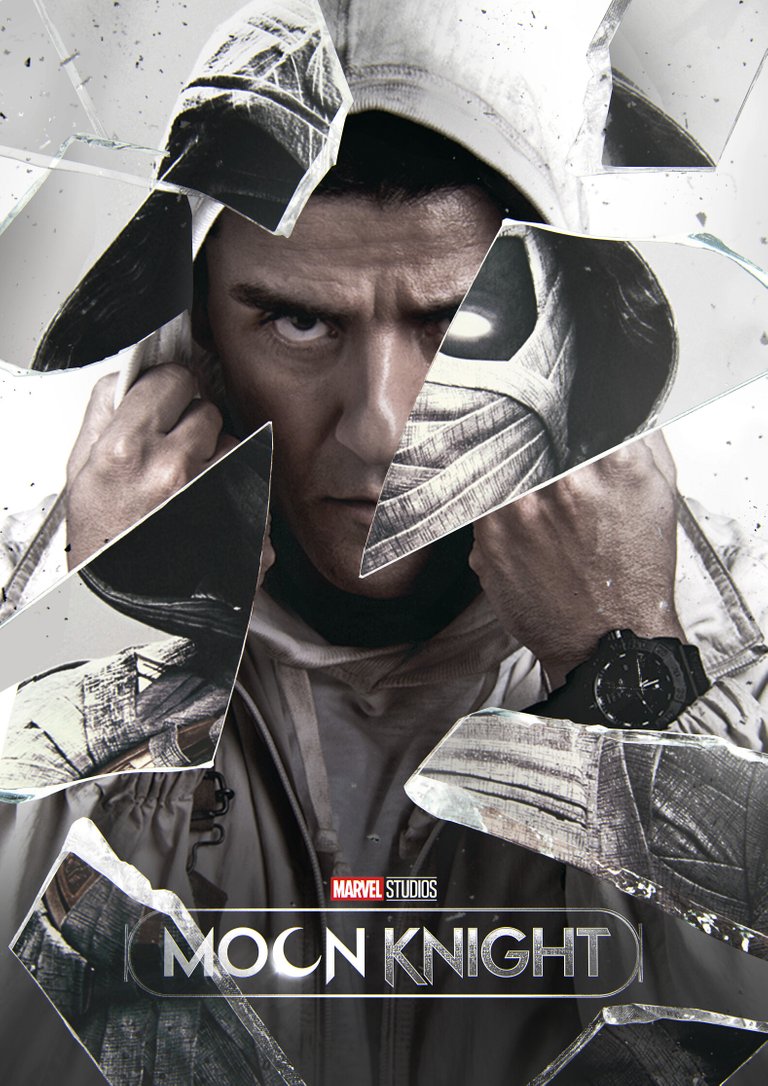

Por otro lado, está el personaje de Layla El-Faouly, que es interpretado por la actriz egipcia-palestina May Calamawy, su actuación es correcta, pero lo que más quisiera destacar es el diseño del personaje, ya que este no es de ese modo en el comics, de hecho, realmente no existe como tal en las historietas, pues el interés amoroso de Marc es Marlene Alraune, la hija del Dr. Peter Alraune, un arqueólogo al que Spector no pudo salvar de ser acecinado por Raoul Bushman, el líder del grupo de mercenarios del que él mismo formaba parte, pero de quien ya Marc estaba cansado, pues no compartía los métodos terroristas que este ordenaba a su equipo realizar, de modo que, aunque no pudo impedir el asesinato del doctor, se dispuso salvar a la hija del arqueólogo, motivo por el que Bushman lo atacó dejándolo mal herido para que muriera, pero apareció Khonsu y le salvó, convirtiéndolo en su avatar y en el antihéroe Moon Knight.
Marlene en los comics es simplemente una damisela en peligro de la que se enamora el protagonista, pero Layla está bastante lejos de ese cliché, en cambio su personalidad es aguerrida y posee grandes destrezas para el combate. Tanto es así, que en el último capítulo ella termina siendo elegida como avatar de Tauret, la diosa de la fertilidad, y tiene una importante participación en la batalla final. Debido al traje que esta diosa le concede, el cual me parece bastante adecuado estéticamente, nos damos cuenta de que en realidad su papel en la historia es una especie de fusión argumental entre el personaje de Marlene y un personaje masculino conocido como Dr. Abdul Faoul, quien portaba el manto del Escarabajo Escarlata (Scarlet Scarab).
Podría escribir sobre unas cuantas cosas más, como la gran forma en que se reestructuro el origen de la fragmentación psicológica de Marc y el surgimiento de la identidad de Steven a causa del maltrato propinado por su madre luego de la trágica muerte de su hermano Randall, la engañosa e inescrupulosa conducta de Khonsu en función de sus avatares, la extraña pero ingeniosa representación onirica en la que Marc alucina un psiquiátrico en el que es tratado por Arthur Harrow o las posibilidades de ver en una nueva temporada a Bushman y a la identidad de Jake Lockley usando su propio traje, que en mi opinión debería ser más oscuro y siniestro, pero ya el post es bastante largo, de modo que cualquier tema relacionado me encantaría ampliarlo en los comentarios.
On the other hand, there is the character of Layla El-Faouly, who is played by the Egyptian-Palestinian actress May Calamawy, her performance is correct, but what I would most like to highlight is the character's design, since this is not that way in the comics, in fact, it doesn't really exist as such in the comics, as Marc's love interest is Marlene Alraune, the daughter of Dr. Peter Alraune, an archaeologist Spector couldn't save from being killed by Raoul Bushman, the leader of the group of mercenaries of which he himself was a part, but of whom Marc was already tired, since he did not share the terrorist methods that he ordered his team to carry out, so that, although he could not prevent the murder of the doctor, he decided to save to the archaeologist's daughter, which is why Bushman attacked him leaving him badly wounded to die, but Khonsu appeared and saved him, turning him into his avatar and the anti-hero Moon Knight.
Marlene in the comics is simply a damsel in distress that the protagonist falls in love with, but Layla is quite far from that cliché, instead her personality is fierce and she has great combat skills. So much so, that in the last chapter she ends up being chosen as the avatar of Tauret, the goddess of fertility, and she has an important role in the final battle. Due to the costume that this goddess gives her, which seems quite appropriate aesthetically to me, we realize that in reality her role in the story is a kind of plot fusion between the character of Marlene and a male character known as Dr. Abdul Faoul. , who wore the mantle of the Scarlet Beetle (Scarlet Scarab).
I could write about a few more things, such as the great way in which the origin of Marc's psychological fragmentation was restructured and the emergence of Steven's identity due to the mistreatment of his mother after the tragic death of his brother Randall, Khonsu's misleading and unscrupulous behavior based on his avatars, the strange but ingenious dream representation in which Marc hallucinates a psychiatric hospital in which he is treated by Arthur Harrow or the possibilities of seeing Bushman and Jake's identity in a new season Lockley wearing his own costume, which in my opinion should be darker and more sinister, but the post is already quite long, so any related topic I would love to expand on in the comments.



Muchas gracias por leer mi contenido, espero haya sido de tu agrado, cualquier opinión, solicitud, critica o sugerencia, por favor comunícamela por medio de los comentarios, será un placer para mi recibirla. Hasta pronto, nos estaremos leyendo próximamente.
Thank you very much for reading my content, I hope it has been to your liking, any opinion, request, criticism or suggestion, please let me know through the comments, it will be a pleasure for me to receive it. See you soon, we will be reading soon.
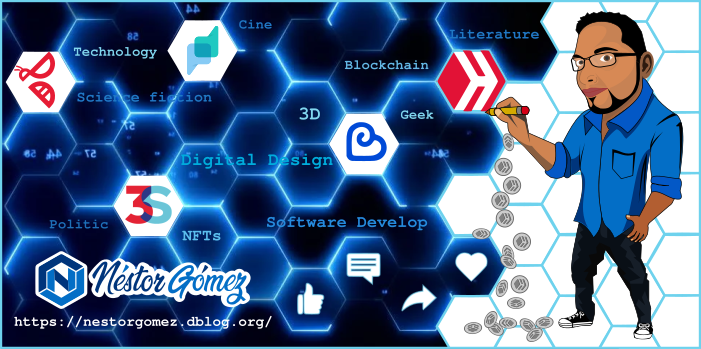
La verdad es una serie muy chida, ojalá que le hagan una peli